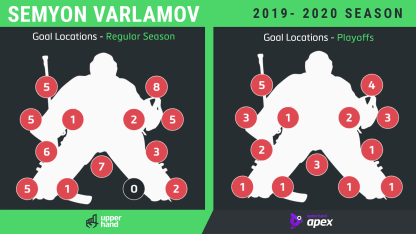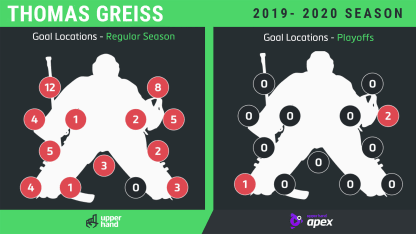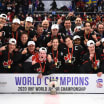Sharp angles: Goals involving post-integration play accounted for 20 percent of his tracked goals in the regular season, and six of 29 this postseason (20.7 percent), but it hasn't been all sharp-angle or low-high attacks. Vasilevskiy tends to stay on his post and sit in reverse-VH, a tactic when the short-side pad is along the ice against the post and the back pad is up with the rear skate used to push into the post and pivot around it, even after the puck moves away from a sharp angle. It cost him on a shot from the hash marks along the boards against the Blue Jackets in the first round this postseason. It can also delay his movements getting off the post to counter quick shots.
Looking over traffic:Vasilevskiy's preference is to look above traffic instead of around it when the play is on the perimeter. To do so, he appears to almost be standing straight up, like he's on tippy toes at times. A late transition to the ice didn't cost him as many goals along the ice as in past seasons, but he can get caught dropping from his high-to-low stance with high shots. That trend seemed to play a role in a number of the surprisingly high 14 mid- and high-glove goals in the regular season.
Lateral and quick:Cross-ice passes and one-timers are a good way to beat any goalie. It's a testament to how well Vasilevskiy is playing that it's taken those high-success plays to score on him in the postseason. Quick releases and one-timers have played a role in 51.7 percent of the goals he has allowed, up from 30 percent in the regular season and above the 37.4 percent average for the more than 6,000 goals tracked during the four years of this project. Goals allowed after passes across the middle of the ice (48.3 percent in the playoffs) are up from 40 percent he allowed in the regular season and from 36.3 percent for the four-year sample size. As fast as Vasilevskiy is, it's important to catch him opening his body while in motion. Goals under his blocker and pads are above the averages, so there is not a need to be too fine in trying to pick corners.
Pucks off pads:Vasilevskiy's rebound goals are also up in the postseason to 27.5 percent from 14 percent, but it's important to remember his pads are designed to create active rebounds, so parking too close to the crease as an opposing forward can cause difficulties in trying to convert.





















